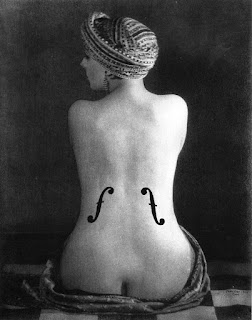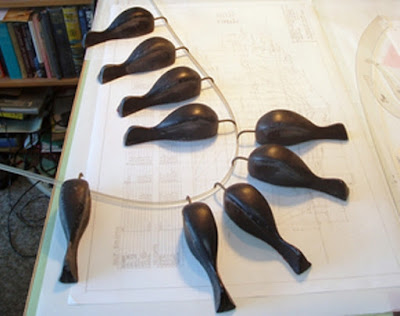And it's somewhat reminiscent of an even more sensuous shape:
But how can a maker draw those iconic violin curves?
Not all curves are created equal. Of course, different makers use different methods to draw curves. There's more than one way. Let's take a look at the options and their differences.
Curves come in families. Some of the families overlap, some don't. Some of the curve families are characterized by mathematical or physical properties, and some by how they are produced.
*************
In modern times, copying the outline of an existing instrument has certainly been the most common way of drawing violin curves. This approach amounts to freehand tracing.
For many makers, this has meant copying the outline of some famous historical instrument to make a template. Once a template is made, the shape can easily be traced out, producing the same curves as many times as desired.
We know that a great portion of violins made after 1800 have been made this way, as copies of the historical Italian instruments. But how did the old Italians themselves create a violin outline? Did they also just copy from older existing instruments?
If we want to draw or create the curves of a violin shape from scratch, how can we? And how might the old Italian makers have approached this? Would we draw freehand, or use geometry or other curve drawing aides? What are the families of curves they might have used?
In the interest of exploring and perhaps reviving the old Italian methods of violin design, lets dive into these rather nerdy esoteric questions. Bring on the curves.
Today, if we want to draw a nice smooth curved shape, we can use a computer program. Typically, we set a few control points for our curve, and the drawing software doesn't just connect them in jagged way, but instead it will smoothly connect these together into a good curve.
What was the old fashion version of this? A spline.
A spline is a springy long wooden stick, or perhaps a suitable straight but flexible wire. A few guide points are pegged in place or otherwise set, and the spline is bent across them forming a nice smooth curve. This technique has a long and documented history in architecture and boat building. It was well known and used in various artisan crafts in Italian at the time violins developed. So this method is certainly a candidate when we consider how the old Italians might have approached a complexly curved shape like the violin.
The use of splines to 'fair a curve' continues (though archaic) with wooden boat builders today. And, the method continued as a practical part of architectural and technical drawing into the 20th century.
This shows the 20th century architectural drawing version of using a spline to draw a smooth curve. Heavy lead 'ducks' are used to set the control points for the curve.
In a different way, pegs and strings can be used to draw a variety of curves. The string can be used to sets distances in the curve in various ways. The curves from different combinations of pegs and strings tend to yield mathematically special shapes, like circles, ellipses, parabolas, et al.
Many other drawing techniques using straight edges and squares turn out to be equivalent to string and peg methods.
Beyond this class of curves, further curves can be generated combining linkages, circles, and gears. Though there is little evidence to suggest these things were much explored before the 19th century, still these methods could have been used at the time the violin came into being. And various people have argued for making a violin shape using such methods.
Particularly, a number of violin makers in recent years have suggested basing the arching of the back and top of the violin on cycloids.
Other violin makers have suggested that violin arches have the shape of a hanging chain, known as a catenary.
The chain shape is physically a very important shape. These shapes, along with their more generalized versions physical represented by hanging wet cloth or as soap film bubble shapes are in a certain sense minimalized shapes. Also, the weight and force of a physical structure like a dome or a bridge travels along catenary shapes. For this reason, to be stable an arch shape must completely contain a chain shape.
We've now touched on all the most distinct curve drawing families. Other methods are mostly going to be variations on these. For example 'French Curves' are essentially templates based on spline drawn curves. And the very important family of 'compass and straightedge' drawn curves can be viewed in 'string and peg' terms.
So lets summarize the distinct curve methods and families we've seen:
- Freehand drawing --- theoretically can produce any curve shape, but isn't easy to cleanly control.
- 'Spline' smoothing between set points --- can also be made to reproduce almost any curve type, if you can select the right points to join.
- 'String and peg' methods can be used to create various curve types with particular mathematical features. Since a string can be pulled straight to emulate a straight edge, and since one end can be pegged to emulate a compass, this category also includes all the straight edge and compass constructions of classical geometry.
- 'Catenary' or hanging chain shapes. Since lines of force follow this shape in an arch, the chain shape was important to architecture even before it was well understood.
- 'Linkages' and circle or gear combinations can lead to some mathematically complex special curves. Cycloids, sine waves, and various Lissajous curves are among the many possibilities through these methods.
So what about an artisan in the 16th century wishing to create a violin shape? The more mathematically complicated shapes like catenary and cycloids weren't widely known or explored at that time. In contrast, compass and rule constructions were dominated.
Old texts and other evidence suggest these geometrical construction were well known and widely used by architects, artists, and artisans. Moreover, the revival of ideas and techniques from the ancient world was popular. Euclid's geometry was a part of this. Even great and famous artists of the time like Da Vinci and Cennini left writings behind suggesting the use of compass and rule to layout guides underneath freehand work.
In Italy at the time the violin developed, compass and rule geometry was important to the architect, artist, typographer, scientist, mathematician, builder, military warfare, and ship navigation just to name a few.
One of the few Italian violin maker texts we have comes from Antonio Bagatella, 1781 in Padua. While Bagatella certainly doesn't reflect the best of Cremona making, still he tries to express the outline of the violin as a compass construction. Even if garbled and imperfect in execution, this still suggests that a compass construction wasn't inconsistent with Italian tradition.
We also have plenty of additional evidence that compasses or dividers played some role in the Cremona making.
The scroll below shows pin pricks along the crest. These and other marks from dividers or compasses are typical in Amati family and other Cremona work.
The dividers shown here have been modify to scribe guide marks onto wood. These are from the city of Cremona collection of tools left over from the Stradivari, Amati, and Ceruti family workshops.
Lastly, notice the little compass rosette doodled on the carving cradle which is usually ascribed to Stradivari, and perhaps goes back to Amati.
Though none of the evidence is conclusive, we must give ample consideration to seeing the classical Italian violin outline as a compass construction.
And to demonstrate the concept, here is an example violin outline constructed only from circle arcs and straight lines:










No comments:
Post a Comment